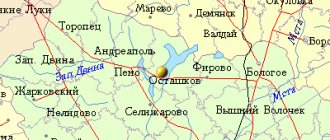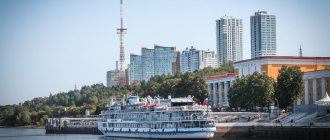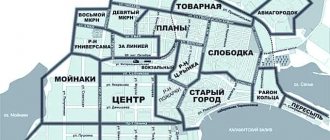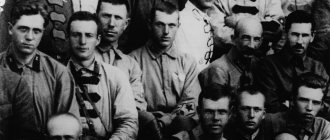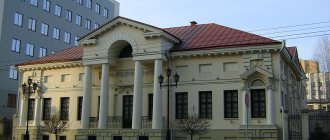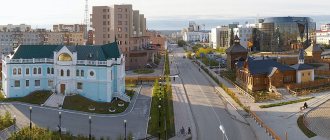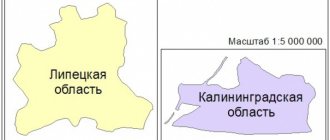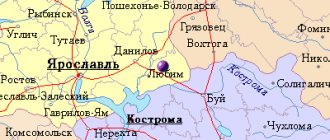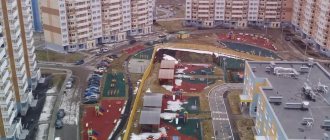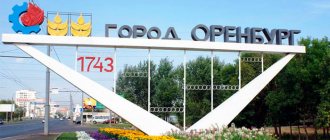The Sovereign Road is a route that has connected Moscow and St. Petersburg for centuries, as well as a new tourist route, on the development of which they plan to rely on in the Tver region (in May it was proposed to include it in the Federal Tourism Development Strategy). When traveling from Moscow, its length, unlike the historical road, is about 400 km, and the end point is not St. Petersburg, but Vyshny Volochek. The small town, located on the shore of a large lake, did not attract the attention of tourists until recently. And in vain - in addition to a network of artificial canals, you can still see a dam built in the 18th century, one of the largest pre-revolutionary residential complexes in the Russian province and the majestic legacy of old industrial empires. And then - stay in a real art studio, located on the territory of the creative “dacha”, where Repin himself once came.
Lake Paradise: in Abrau-Durso for the weekend
A developed tourist infrastructure has been created around the unique natural monument
Izvestia correspondents drove along the “royal” route in a Mitsubishi Pajero Sport to see what secrets it kept and to check whether the local roads were very different from pre-revolutionary ones.
See perspective
The fastest way to get to Vyshny Volochok is through toll sections of the M-11 highway: they save about an hour of time and are inexpensive. The quality of the road surface is good and allows you to drive at a maximum speed limit of 130 km/h.
Vyshny Volochek itself, if you look closely, is a district town with St. Petersburg ambitions: the prospects of the avenues and main streets here are calibrated as if using a ruler. The continuous façade construction also reminds us of the Northern capital. Few other places in the Russian provinces can now be seen with so many old mansions built wall to wall.
drag
Photo: IZVESTIA/Evgeniy Bagdasarov
Now Volochek bypasses Leningradka, but for a long time the road connecting Moscow and St. Petersburg passed right through the city. Therefore, now, local historians joke, a monument can be erected here to almost any eminent figure in Russian history - all of them have visited the city at least once.
If you dig deeper and get acquainted with the history of the city, even briefly, it immediately becomes clear that, firstly, the residents loved their city (this can be felt through the centuries), and secondly, they were resourceful people.
Watermelon blockage: what to do in summer on the banks of the Volga
Wild mustangs and a lotus lake, Saxon baroque and ancient sites, cheese factories, wineries and the famous mustard oil - what is the Volgograd land rich in?
Vyshny Volochyok
(Tver region)
OKATO code:
28414
Founded:
1471
City since:
1770 City of regional subordination
Center:
Vyshnevolotsky district
Urban-type settlements, population as of 01/1/2021
| Krasnomaysky | 4.4 |
| Telephone code (reference phone) | |
| 48233***** | 12-3-98 |
Deviation from Moscow time, hours:
0
Geographic latitude:
57°35′
Geographic longitude:
34°34′
Altitude above sea level, meters:
160 Sunrise and sunset times of the Sun and Moon in the city of Vyshny Volochyok
Find out about the “fight” between the innkeeper and the Dutch masters
At the beginning of the 18th century, local innkeeper Mikhail Serdyukov was able to create a canal system that turned Volochek - then not a city, but a large trading village lying on the way from the Volga to the Baltic - into one of the most important transport hubs of the empire.
At the same time, Serdyukov managed to solve a problem that was beyond the power of the Dutch masters: Peter I, fired up with the idea of replacing the inconvenient portage with a network of canals, first sent them to Volochek. But foreign experts made a mistake when calculating the water level required for the canals, and soon the canals were covered with silt.
After the first canals fell into disrepair, the merchant, who is now more often called a self-taught hydraulic engineer, offered to build new ones at his own expense, according to the scheme he had developed. But - in exchange for the right to manage canals (and, accordingly, to collect all taxes associated with them) and, most importantly, in exchange for the right to collect taxes from taverns located in the coastal zone.
drag
Photo: IZVESTIA/Evgeniy Bagdasarov
According to the extended program: where to go on holidays in the vicinity of the capital
Migratory birds, an ancient hydroelectric power station, a shoe, bagels and other joys of the Moscow region
Now Serdyukov is called the creator of not only one of the largest hydraulic systems in Europe, but also the first reservoir in the country (today it is Lake Vyshevolotsk). For the first time in the Russian Empire, he proposed using the principle, familiar to many, of alternating water levels, which could be either raised or lowered with the help of sluices. So the public-private partnership, which is talked about so much today, was a great success in Vyshny Volochyok in the 18th century.
You can still see the fruits of the efforts of the Mongol innkeeper in the city today. Since the times of Peter the Great, the system has not changed much: the canals (there are two main ones here - Tsninsky and Tveretsky ) are dressed in granite of the 19th century, which was used for the reconstruction of the system, and on the supports of some bridges you can see notches, which, according to legend, appeared under the pressure of the ropes of barge haulers. This, however, is not certain. Perhaps the notches appeared during construction work or under completely different conditions.
Author of the quote
By the way, Serdyukov, who remains something of a folk hero in the city, was not a native of Volochok at all - he was Mongolian by origin, he was captured as a child and over time he ended up in Novgorod, in the care of local merchants. And from there he moved to Volochek.
The Tsninsky beishlot deserves special attention . The dam, built on the Tsna River, at the beginning of the 18th century became one of the important elements of the plan proposed by Serdyukov - and is still in use. Since it is an active hydraulic structure, you can’t get close to the structures, but it’s still worth a visit.
drag
Photo: IZVESTIA/Evgeniy Bagdasarov
Another attraction connected with the canals is the estate of Mikhail Serdyukov himself, from which the main house and part of the outbuildings have been preserved. But in general there are many more such estates here. It is not for nothing that a whole host of famous industrialists, philanthropists and artists visited these places. If Volochek itself can be explored in a few hours, then in order to go around all the estates, you will have to set aside a separate day (and better yet, more than one).
Author of the quote
Water is one of the main natural attractions of Vyshny Volochyok, therefore, when going here, you need to set aside time for a trip outside the city, to Lake Vyshny Volochyok, which locals often call a reservoir. By the way, you can also go surfing or fishing there.
Ancient Rus' with a Swiss flavor: what to see and try in Zvenigorod
From Levitan's landscapes to the RAS observatory and kelp ice cream
Kazan Convent in Vyshny Volochyok
On the eastern outskirts of Vyshny Volochok lies one of the most valuable attractions of the city - the Kazan Convent. The monastery was formed in 1881 from a women's community that had existed on this site since 1871. By the beginning of the twentieth century, it had become one of the largest in the Tver region, employing more than 1,000 novices.
Kazan Monastery in Vyshny Volochyok
After the revolution of 1917, the monastery was closed; the Tver Rifle Division was located on its territory, and later a military unit. Now it’s clear why the monastery is surrounded by such a creepy fence.
Entrance to the Kazan Monastery in Vyshny Volochyok
The main dominant feature of the entire monastery ensemble and the real decoration of the monastery is the Kazan Cathedral . It was designed by the famous Moscow architect A. S. Kaminsky and can rightfully compete for the title of the most beautiful cathedral in Russia.
Kazan Cathedral in Vyshny Volochyok
Construction of the elegant Kazan Cathedral began in 1877 and was completed in 1882. The cathedral is given special beauty by two semicircular towers located on the edges of the main entrance, and 14 small domes on decorative drums. A powerful rotunda with a spherical dome, also crowned with a small dome, is built above the central part of the cathedral. The facades are decorated with high triple windows.
Kazan Cathedral in Vyshny Volochyok
Kazan Cathedral in Vyshny Volochyok
Restoration work is still ongoing inside the cathedral.
Kazan Cathedral in Vyshny Volochyok
To the right of the Kazan Cathedral you can see the chapel of Faith, Hope, Love and their mother Sophia , built after the revival of monastic life within the monastery walls in 1999.
Kazan Cathedral with a chapel in Vyshny Volochyok
Chapel of Faith, Hope, Love and Sophia in Vyshny Volochyok
In the south-eastern corner of the monastery in 1897-1901. Andronikov Church was built . Externally, the church is a classic cross-domed church with five domes.
Andronikov Church in Vyshny Volochyok
From the side of the main entrance, a number of buildings adjoin the Andronikov Church. Let's look at them in order.
The first small two-story extension is an old hospital building . It is followed by an openwork transition between the buildings , made in the Old Russian style.
Andronikov Church and the old hospital building in Vyshny Volochyok
The Old Hospital Building (yellow), the Rectory Building (white) and the passage between them
Next comes the long white rectory , built in 1889.
The abbot's corps in the Kazan Monastery of Vyshny Volochok
Another dominant feature of the monastery is the bell tower with the Ephraim Church (1883-1888). The church with a three-tier bell tower was erected at the expense of the spouses Ephraim and Neonila Sivokhin.
Bell tower with the Ephraim Church in the Kazan Monastery of Vyshny Volochok
At the base of the church there is a two-story quadrangle, on the second floor of which the church is located. Like the main monastery church (Kazan Cathedral), the bell tower is decorated with tall triple windows.
Bell tower with the Ephraim Church in the Kazan Monastery of Vyshny Volochok
The ancient building next to the bell tower is a refectory and a hotel . This building was built in the 1880s. practically together with the Kazan Cathedral especially for the pilgrims (pilgrims) visiting the monastery.
Refectory with a hotel in the Kazan Monastery of Vyshny Volochok
Refectory with a hotel in the Kazan Monastery of Vyshny Volochok (end view)
On the other side of the bell tower lie the ruins of another building - this is a new hospital building , built in 1889. Someday it will definitely be restored.
New hospital building in the Kazan Monastery of Vyshny Volochok
New hospital building in the Kazan Monastery of Vyshny Volochok
A couple of wooden and semi-wooden monastic cells from the late 19th century have survived in the monastery. During the heyday of the monastery, there were about 15 such buildings.
Monastic cells in the Kazan Monastery of Vyshny Volochok
Monastic cells in the Kazan Monastery of Vyshny Volochok
And this is the overhead chapel from 1889:
The over-kladeznaya chapel in the Kazan monastery of Vyshny Volochok
A small chicken coop as a reminder of the glorious times of the late 19th century, when the monastery owned a vast barnyard and even its own mill.
And finally, a few more photos of the Kazan Cathedral:
Kazan Cathedral in Vyshny Volochyok
Kazan Cathedral with bell tower in Vyshny Volochyok
Look at the millstones of history
No matter how attractive the canals were, especially in the heat and after several hours of driving along Leningradka, and the fascinating history of their construction, including fierce battles between St. Petersburg nobles for the right to expensive government contracts, they lost their economic significance already in the 19th century, with the launch of the Nikolaevskaya railway.
But the townspeople were not at a loss here either, reorienting themselves to trade and industry. The merchant past of the city is reminded, for example, by two buildings of the Trading Rows standing on Kazansky Prospekt (they are really in a very poor condition). And also - elegant (once) two- and three-story mansions lined up in neat rows. Previously, these were apartment buildings, and the laid-out arches in the first floors remind of the shops that nested here.
drag
Photo: IZVESTIA/Evgeniy Bagdasarov
Now there are all kinds of small businesses and residential apartments located there, some of the buildings are under reconstruction or are looking forward to it. But, despite the peeling plaster, they have not lost their charm. Even the exquisite French balconies with intricate grilles have survived: they are decorated differently in each house.
Author of the quote
Kazansky Avenue, Ekaterininskaya Street leading from it and the Vanchakov Line laid along the Tsninsky Canal are the main “centers of power” in the historical part of the city. The preserved historical station building is also worth a look. Don’t be lazy to go inside: pre-revolutionary cupronickel tiles, some old lamps and twisted staircase supports have been preserved there. In general, this does not look like ordinary provincial train stations. The former magistrate's building with a fire tower built above it also deserves attention.
Right there, in the center, on the embankment of the Tsninsky Canal, you can see a monument to the fathers and architects of the city , erected several years ago through the joint efforts of residents and local historians. They specially brought here a memorial chapel from the beginning of the 20th century, ancient stone millstones and granite supports from the historical bridges of the St. Petersburg-Moscow road.
Stands apart: how the forgotten dacha of the Ryabushinskys is being saved
And is it possible to revive an old house with parquet flooring, fireplaces and a pre-revolutionary bathroom on your own?
The location was not chosen by chance: the monument stands on the site of the summer Kazan Cathedral, which was demolished at the end of the 18th century. Now nearby is another cathedral, the Epiphany Cathedral, built at the beginning of the 19th century, and in the east of the city stands the magnificent ensemble of the Kazan Monastery, built at the end of the century before last in the pseudo-Russian style.
Kazansky prospect
Kazansky Avenue is considered the main street of Vyshny Volochok. It starts at the Tveretsky Canal and, crossing many streets, ends at the railway station. The length of Kazansky Avenue is 2.3 km. It is on Kazansky Avenue that the most important historical sights of the city are collected.
Shopping arcades of Vyshny Volochyok
Kazansky Avenue got its name from the Kazan Cathedral, built in the 1760s. in the center of a spacious shopping area on the site of a previously burnt wooden temple. The monumental five-domed temple with characteristic Baroque features for a long time remained the largest building of Vyshny Volochok and its main architectural dominant.
Kazan Summer Cathedral in Vyshny Volochyok. Destroyed in 1935.
The ensemble of the trading area continued to be formed until the very end of the 18th century. During this time, a bell tower and two L-shaped buildings of the Gostiny Dvor were erected, symmetrically framing the Kazan Cathedral. The construction of two trade buildings at once was justified by the fact that Vyshnevolotsk merchants were the richest in the Tver region, and the city hosted as many as three fairs a year. After the construction of the fence in 1805, the architectural composition of the central part of the city was completely completed.
A little more than two hundred years have passed since then, and practically nothing remains of the former grandeur of the shopping area. In 1935, the Kazan Cathedral was blown up, and later a district court was built in its place. A monument to Lenin was erected on the site of the bell tower.
Monument to V.I. Lenin in Vyshny Volochyok
Although the shopping arcades of the former Gostiny Dvor have survived to this day, they are in extremely depressing condition. However, even so, these high long galleries with vaulted ceilings look amazing and create a lot of interest!
Shopping arcades in Vyshny Volochyok
The shopping arcades are recognized as an architectural monument of federal significance, but they continue to deteriorate year after year. In 2017, the last stores in the shopping arcades were closed due to roof collapse.
Shopping arcades in Vyshny Volochyok
Shopping arcades in Vyshny Volochyok
And if the buildings look even more or less acceptable from the outside, inside, over the long years of desolation, an entire jungle has managed to grow!
Shopping arcades in Vyshny Volochyok
Shopping arcades in Vyshny Volochyok
Shopping arcades in Vyshny Volochyok
Honestly, judging by the shabby appearance of the entire city, there is not much hope for the restoration of the shopping arcades. Time will tell how events will develop.
Shopping arcades in Vyshny Volochyok - southern building. Address: Kazansky prospect, 16 B
On the south side of the shopping arcades you can see the administration of Vyshny Volochok with a bust of Peter I installed in front of the entrance (2007). The signature under the bust reads: “To the great creator of the Vyshnevolotsk water system.” Still, this is not entirely true. Peter, of course, contributed to the creation of the channels, but the main merit, as we already know, belongs to another person. In general, it would be better if the Textile Workers Park was put in order, rather than casting new monuments and then laying tiles around it...
Administration of Vyshny Volochok and bust of Peter I. Address: Kazansky Prospekt, 17
And immediately it is impossible not to notice a two-story building of respectable size - this is gymnasium No. 2. Initially, in 1907, it was a real school that trained financiers and economists for the city’s industrial enterprises. Over the years, the school became secondary school No. 2, and since 1998 - a lyceum.
Lyceum No. 2 in Vyshny Volochyok. Address: st. Venetsianova, 1
The lyceum building is very large: one side faces Kazansky Prospekt, the other side faces the shopping arcades, and the third faces the embankment of the Tsna River.
Lyceum No. 2 in Vyshny Volochyok
And this is a row of houses on Kazansky Avenue, located opposite the shopping arcades. It's all offices and shops.
A row of houses on Kazansky Prospekt in Vyshny Volochyok at numbers 21-31
Venice Square and Drama Theater of Vyshny Volochok
Further along Kazansky Prospekt, right behind the shopping arcades, is Venice Square. Holidays and folk festivals, meetings with friends, dates, etc. are held here. There is also a bus station next to the park.
Venetian Square in Vyshny Volochyok
The northern building of the shopping arcade, facing the square, looks extremely deplorable.
Shopping arcades in Vyshny Volochyok - northern building. Address: Kazansky prospect, 18A
It just so happened that our arrival came at the very height of renovation work to improve the square, and therefore various building materials and “loosened” asphalt will be periodically present in the footage.
Venetsianov Square in Vyshny Volochyok
A stage and fountain are being built here.
Construction of a stage in the center of Vyshny Volochok
Construction of a fountain in the center of Vyshny Volochok
Some paths are guarded by lions: some ferocious and some not so fierce.
